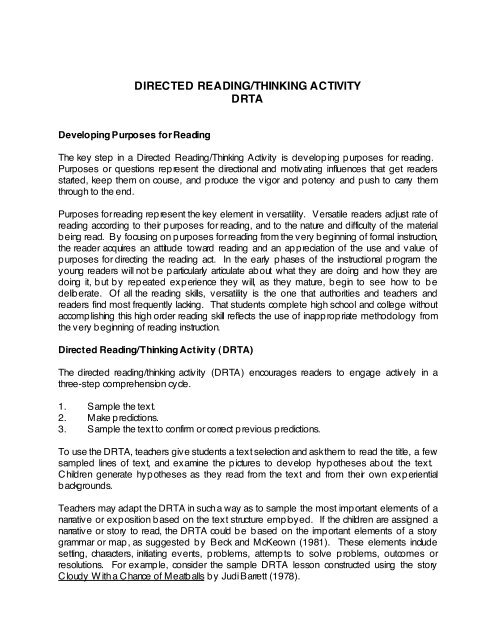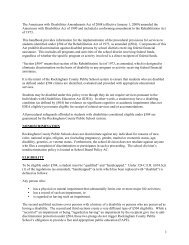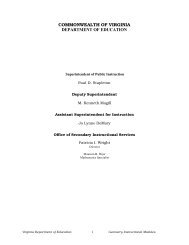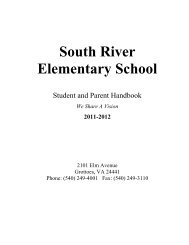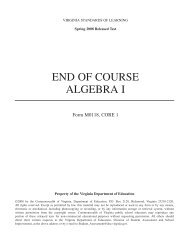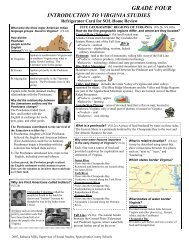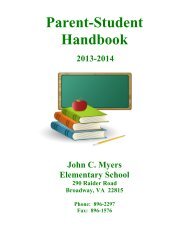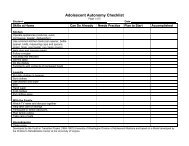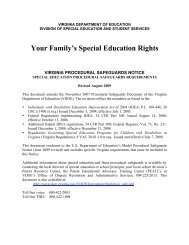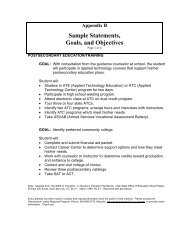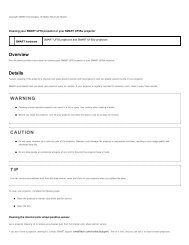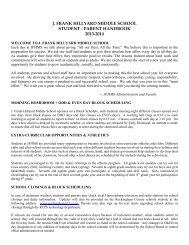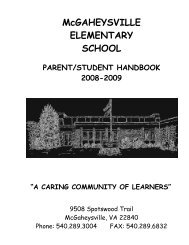DIRECTED READING/THINKING ACTIVITY DRTA
DIRECTED READING/THINKING ACTIVITY DRTA
DIRECTED READING/THINKING ACTIVITY DRTA
Create successful ePaper yourself
Turn your PDF publications into a flip-book with our unique Google optimized e-Paper software.
<strong>DIRECTED</strong> <strong>READING</strong>/<strong>THINKING</strong> <strong>ACTIVITY</strong><br />
<strong>DRTA</strong><br />
Developing Purposes for Reading<br />
The key step in a Directed Reading/Thinking Activity is developing purposes for reading.<br />
Purposes or questions represent the directional and motivating influences that get readers<br />
started, keep them on course, and produce the vigor and potency and push to carry them<br />
through to the end.<br />
Purposes for reading represent the key element in versatility. Versatile readers adjust rate of<br />
reading according to their purposes for reading, and to the nature and difficulty of the material<br />
being read. By focusing on purposes for reading from the very beginning of formal instruction,<br />
the reader acquires an attitude toward reading and an appreciation of the use and value of<br />
purposes for directing the reading act. In the early phases of the instructional program the<br />
young readers will not be particularly articulate about what they are doing and how they are<br />
doing it, but by repeated experience they will, as they mature, begin to see how to be<br />
deliberate. Of all the reading skils, versatility is the one that authorities and teachers and<br />
readers find most frequently lacking. That students complete high school and college without<br />
accomplishing this high order reading skil reflects the use of inappropriate methodology from<br />
the very beginning of reading instruction.<br />
Directed Reading/Thinking Activity (<strong>DRTA</strong>)<br />
The directed reading/thinking activity (<strong>DRTA</strong>) encourages readers to engage actively in a<br />
three-step comprehension cycle.<br />
1. Sample the text.<br />
2. Make predictions.<br />
3. Sample the text to confirm or correct previous predictions.<br />
To use the <strong>DRTA</strong>, teachers give students a text selection and ask them to read the title, a few<br />
sampled lines of text, and examine the pictures to develop hypotheses about the text.<br />
Children generate hypotheses as they read from the text and from their own experiential<br />
backgrounds.<br />
Teachers may adapt the <strong>DRTA</strong> in such a way as to sample the most important elements of a<br />
narrative or exposition based on the text structure employed. If the children are assigned a<br />
narrative or story to read, the <strong>DRTA</strong> could be based on the important elements of a story<br />
grammar or map, as suggested by Beck and McKeown (1981). These elements include<br />
setting, characters, initiating events, problems, attempts to solve problems, outcomes or<br />
resolutions. For example, consider the sample <strong>DRTA</strong> lesson constructed using the story<br />
Cloudy W ith a Chance of Meatballs by Judi Barrett (1978).
Example <strong>DRTA</strong> Lesson<br />
The teacher begins the lesson by showing the book and saying:<br />
The title of the book we're going to read today is Cloudy W ith a Chance of Meatballs. W hat<br />
do this title and the picture make you think the story is about?<br />
John:<br />
It might be about an old man that makes a magic spell on the sky so that meatballs<br />
come down when he wants to eat them.<br />
Lisa:<br />
sky.<br />
I think it might be about a place where any kind of food you want rains down from the<br />
Te ache r:<br />
Let's read and see how close your predictions are.<br />
The te ache r the n re ads until the town of Che wandswallow is de scribe d.<br />
Te ache r:<br />
Childre n:<br />
Te ache r:<br />
Now, do you still agree with your predictions?<br />
It sounds like it's going to be about a place like Lisa described.<br />
What makes you think so?<br />
Je ssica: Because they haven't talked at all about an old man, the author only described the<br />
town and how food rained down for breakfast, lunch, and dinner.<br />
Te ache r:<br />
Would you like to live in a town like Chewandswallow?<br />
S usan:<br />
I think it would be fun because then you wouldn't have to wait for your mom<br />
to cook dinner. You could just catch some extra food and eat when you were hungry.<br />
Tyle r:<br />
I wouldn't like it cuz what would happen if it rained something heavy like barbecued<br />
ribs and you got hit on the head and got knocked out or died.<br />
Te ache r:<br />
town?<br />
Je ff:<br />
Maria:<br />
Tyler brought up a good point. Could there be some problems with living in this<br />
It could rain heavy things and hurt you.<br />
If there were a storm of ice cream or something mushy it would get really messy.<br />
Te ache r: Good, now that you're thinking about what a place like Chewandswallow would be<br />
like, let's read on to see what happens in the town.<br />
S he re ads until the we athe r take s a turn for the worse.<br />
Te ache r:<br />
Now what do you think is going to happen in the story?<br />
Jame s:<br />
It's about a town that rains food for breakfast, lunch, and dinner and then<br />
one day the food starts coming down funny.<br />
Te ache r:<br />
What do you mean by funny?
Jame s:<br />
Te ache r:<br />
I think that maybe too much food started coming down.<br />
What makes you think that maybe too much food started coming down?<br />
Jame s:<br />
can't move.<br />
Well, in the picture there is too much spaghetti in the road and the cars<br />
Te ache r:<br />
Good, now let's continue reading to see if you are right.<br />
The teacher now reads until the story describes a tomato<br />
tornado and then stops and asks questions again.<br />
Te ache r:<br />
So, what happens in the town of Chewandswallow?<br />
Kayla:<br />
All kinds of food starts coming down. Some of it is yucky like peanut butter,<br />
mayonnaise, and brussels sprouts. And sometimes just too much of it comes down, like<br />
when they had a tomato tornado. Everything was a mess because the food was going<br />
crazy.<br />
Te ache r:<br />
What do you think the town will do about it? Why do you think so?<br />
Frank:<br />
I think that they will hire a magician to put a spell on the clouds so that the weather<br />
will get straightened out because sometimes in the stories they can do that.<br />
Harold:<br />
would do.<br />
I think that they have to leave if they can, before they all die. That's what I<br />
Nancy: I think they need to find out who is in charge of making it rain so that they can ask<br />
them to stop it and make things go back to normal.<br />
Te ache r: Those are good answers. Now I want you all to decide which of those you think is<br />
the most likely to happen and let's continue reading.<br />
The te ache r re ads the re st of the book.<br />
Te ache r: Did the people do what you thought they would do? Did you like how they solved<br />
their problem?<br />
Harold:<br />
Yes, that's what I thought they should do.<br />
Frank:<br />
No, I still think they should've called on somebody to help them so that they<br />
wouldn't have to leave Chewandswallow and have to buy groceries in the store.<br />
A <strong>DRTA</strong> could also be extended for use with expository texts such as those found in the<br />
classroom science, health, and social studies textbooks.<br />
Source:Reutzel, Ray D. and Robert B. Cooter, Jr., Teaching Children to Read: From Basals to Books New<br />
York: Macmillan Publishing Co., 1992<br />
Video tapes available from Language Arts Supervisor.


